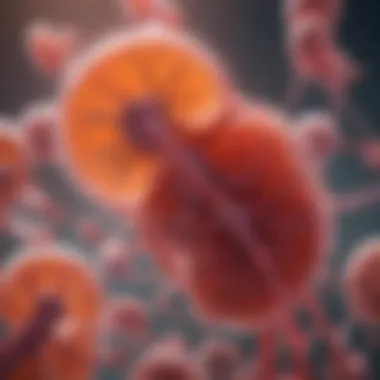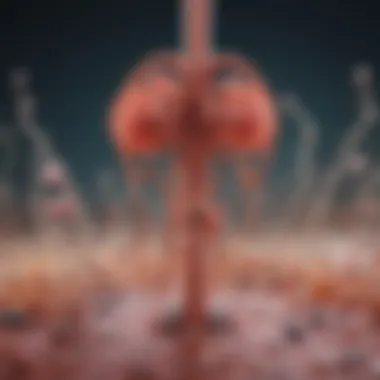Complement Activation in IgA Nephropathy Explained


Intro
IgA nephropathy, also known as Berger's disease, has garnered increasing attention due to its rising prevalence, particularly among the younger population. This disorder manifests through the abnormal deposition of immunoglobulin A in the glomeruli, the delicate filtering structures in the kidneys. Understanding the mechanisms that contribute to this condition is crucial for developing effective treatment strategies.
One pivotal player in the pathogenesis of IgA nephropathy that warrants specific attention is the complement system. This intricate network of proteins not only helps clear pathogens but also plays a role in tissue homeostasis. In the case of IgA nephropathy, the complement system's activation can exacerbate the underlying disease process, leading to glomerular damage and renal impairment.
A deep dive into the interplay between complement activation and IgA nephropathy reveals not only the complexities of the disease but also the potential avenues for targeted therapeutic interventions. This article provides a thorough exploration of the existing body of research, shedding light on how complement pathways interact with IgA deposition and the resultant renal pathology.
As we navigate through the sections, expect to uncover both historical insights and current trends related to this disorder, ultimately providing a well-rounded framework for understanding how complement factors contribute to disease progression in IgA nephropathy.
Prologue to IgA Nephropathy
IgA nephropathy, also known as Berger's disease, is an intriguing disorder that has captured the attention of nephrologists and researchers alike. This condition revolves around the deposition of immunoglobulin A in the glomeruli of the kidneys, resulting in a spectrum of clinical outcomes that can vary from asymptomatic hematuria to progressive kidney failure. The importance of understanding this disease lies not only in its potential severity but also in the intricate mechanisms, particularly the role of the complement system, that underlie its pathology.
As we embark on this exploration, it is important to note that IgA nephropathy is one of the most common forms of primary glomerulonephritis worldwide, affecting individuals across all age groups. Understanding IgA nephropathy's biology is critical for developing effective treatments and improving patient outcomes. Key elements include its definitions, epidemiology, and how the interplay of immune response components affects the disease progression.
Definition and Overview
IgA nephropathy is characterized chiefly by the aberrant production and accumulation of IgA antibodies in the renal glomeruli. This accumulation generally triggers an inflammatory response, leading to the activation of various immune pathways, including the complement system. Patients with this condition often present with symptoms such as blood in urine, proteinuria, and sometimes swelling, reflecting the renal impairment occurring at different stages.
One unique aspect of IgA nephropathy is its unpredictable course. Some individuals might experience a benign condition, while others develop chronic kidney disease, necessitating interventions like dialysis or transplantation. The variability in clinical outcomes underscores the need for a nuanced understanding of the pathogenic mechanisms involved, especially regarding complement activation.
Epidemiology
The prevalence of IgA nephropathy varies widely across geographical and ethnic boundaries, with some studies indicating higher rates in Asian populations compared to Western countries. In many regions, it stands out as the leading cause of end-stage renal disease, particularly among younger adults. According to recent data, the incidence rates can be as high as 2-6 cases per 100,000 individuals annually.
- Key Epidemiological Insights:
- IgA nephropathy often presents in the second or third decade of life.
- It has a male predominance, with estimates suggesting that men are affected approximately 1.5 to 2 times more often than women.
- The global distribution shows variations, with higher rates in Asian and Scandinavian countries compared to Africa and South America.
The impact of genetic factors, environmental triggers, and infectious agents on the onset and progression of IgA nephropathy is an active area of research and remains pivotal for understanding its epidemiology. The interplay between these factors and complement system activation is essential, as it may offer insights into tailored therapeutic approaches.
"Understanding the risk factors and the biological underpinnings of IgA nephropathy is critical for devising informed clinical strategies to manage this complex condition."
In summary, the introduction to IgA nephropathy sets the stage for a comprehensive examination of its pathophysiology, particularly the role of the complement system, and highlights the necessity for ongoing research. Through this lens, we can better grasp how to navigate the clinical challenges posed by this prevalent disorder.
The Complement System
The complement system serves as a crucial component of the immune response, acting as a bridge between innate and adaptive immunity. In the context of IgA nephropathy, understanding this system is not just beneficial but essential. The complement system consists of a series of proteins that enhance the ability of antibodies and phagocytic cells to clear pathogens from an organism. It plays a significant role in inflammation and contributes to the homeostasis of bodily functions. Thus, its implications in IgA nephropathy, especially how it can exacerbate or ameliorate kidney injury, are vital for both researchers and clinicians.
Basic Components of Complement
At its core, the complement system is made up of numerous proteins, mainly secreted by the liver, which circulate in the bloodstream in their inactive forms. When activated, these proteins act sequentially in a cascade-like manner. Key players include
- C1, which initiates the classical pathway,
- C3, the most central fragment that marks the next steps in both the classical and alternative pathways, and
- C5, which triggers the final assembly of the membrane attack complex.
The active fragments contribute to opsonization, inflammation, and cell lysis, showcasing the multi-functional nature of this system.


Activation Pathways
The activation of the complement system occurs through three main pathways, each with unique initiating mechanisms yet converging on a common endpoint. Understanding these pathways is paramount for grasping how complement factors influence disease outcomes.
Classical Pathway
The classical pathway is largely dependent on the presence of antibodies. When antibodies bind to an antigen, such as in the case of persistent IgA deposits in the kidneys, they trigger C1 activation. This pathway's main trait is its ability to link the adaptive immune response to the effector activity of the complement system, thus playing a significant role in the clearance of immune complexes. One distinct advantage of this pathway is its specificity; it responds to known antigens which increases its efficacy.
However, this specificity can sometimes backfire, especially in IgA nephropathy, leading to an excessive immune response that could exacerbate kidney injury.
Lectin Pathway
In contrast to the classical pathway, the lectin pathway does not require antibodies for activation. Instead, it recognizes carbohydrates on the surface of pathogens or altered self-cells. The key characteristic here is that it can activate the complement system independently of antibodies, making it a versatile mechanism in various pathological states, including those with altered glycosylation patterns often observed in kidney diseases. This feature helps expand the immune response but can result in undesired amplification of complement activation, linking it closely to the pathophysiology of IgA nephropathy.
Alternative Pathway
The alternative pathway is continuously active at low levels and acts as a first line of defense against pathogens. It can get triggered spontaneously when C3 undergoes hydrolysis. This pathway does not rely on antibodies, making it crucial in situations where the immune system is already under siege, such as in IgA nephropathy. Its unique feature is that it can amplify responses generated by the classical and lectin pathways, thus rapidly escalating complement activation when needed. However, this can also lead to overactivity, posing risks for tissue damage in the kidneys.
Functional Roles of Complement
The roles of complement in the immune system extend beyond the mere destruction of pathogens. The complement system also facilitates the opsonization of microbes, making them more recognizable to phagocytes, and induces inflammation that can attract immune cells to areas of infection or tissue injury. In the context of IgA nephropathy, the dysfunction or dysregulation of the complement system can severely impact kidney health, leading to chronic inflammation and progressive renal damage.
"Understanding the complement system in the context of IgA nephropathy is like connecting dots in a complex puzzle—each pathway and component plays a critical role in the bigger picture of immunological health."
In essence, the complement system is not just a passive player. Its intricate and multifaceted roles make it both a potential ally in fighting infections and a complicator in autoimmune mechanisms such as those seen in IgA nephropathy.
The interplay of its pathways and components underscores the relevance of focusing on the complement system when addressing IgA nephropathy as a disease that requires a holistic understanding of immune mechanisms.
Pathophysiology of IgA Nephropathy
Understanding the pathophysiology of IgA nephropathy (IgAN) is crucial for unraveling the complexities of this kidney disorder. This knowledge helps researchers, clinicians, and patients grasp the underlying mechanisms that lead to the disease, which ultimately informs treatment and management strategies. IgAN is not just a single problem; it’s a web of interactions between various immunological elements, cellular behaviors, and genetic predispositions. The complement system plays a notable role in initiating and perpetuating the damage that characterizes this disease. Delving into these specifics can pinpoint where therapeutic interventions might be most effective.
Immunological Mechanisms
At the heart of IgA nephropathy lies the interaction between the immune system and the kidney. The disease presents due to abnormal immunological responses, particularly involving immunoglobulin A (IgA). In healthy conditions, IgA serves as a primary line of defense in mucosal immunity, yet in individuals with IgAN, there's aberrant overproduction or under-clearing of this antibody. This leads to its deposition in the mesangial area of the glomeruli.
Complement activation is intertwined with these immunological mechanisms. When IgA binds to its antigens, it inadvertently triggers the complement cascade, specifically through the lectin pathway. This activation can cause inflammation and subsequent glomerular injury, shedding light on how the immune response can become a double-edged sword. The role of complement not only amplifies the inflammatory response but also modulates cellular activities that are detrimental to kidney structures.
Cellular Interactions in the Kidney
The kidney’s cellular landscape is profoundly affected in IgA nephropathy. The glomerular endothelial cells, mesangial cells, and podocytes all play critical roles in maintaining glomerular function. In the context of IgAN, these cells undergo various changes due to inflammatory processes initiated by complement activation.
For instance, podocytes, which are essential for filtration, can become retracted or even undergo apoptosis due to inflammatory mediators. Mesangial cells, when activated, proliferate and secrete more extracellular matrix components, leading to glomerular fibrosis, a process that severely impairs kidney function.
The intricate interplay among these cellular components also highlights how cellular signaling pathways can contribute to disease progression. If we picture the kidney as a bustling city, complement activation acts like an unregulated permit, allowing destructive construction projects to tarnish the landscape. Thus, these cell interactions are not just passive; they are actively engaging in the development and progression of disease.
The Role of Glomerular Injury


Glomerular injury is perhaps the most observable outcome in IgA nephropathy, but its origins are deeply rooted in the disease’s immunological and cellular dysfunctions. The initial deposition of IgA in the glomeruli triggers a cascade of inflammatory responses that culminate in damage to the glomerular architecture. This injury is manifested through various changes such as hypercellularity and glomerulosclerosis.
"To understand IgAN, one must recognize that glomerular injury is both a response to and a perpetuator of the disease process."
Several studies suggest that ongoing glomerular injury correlates with disease progression, making it a critical focus for therapeutic intervention. This injury isn't just an isolated event; it sets in motion a vicious cycle where further immune responses lead to more damage, emphasizing the need for early and targeted treatment.
The interconnectedness of these mechanisms illustrates the complexity of IgA nephropathy. The influence of complement activation, when coupled with the unique immunological milieu and the dynamic kidney cellular interactions, forms a perfect storm that can lead to chronic kidney disease if not addressed.
The faster clinicians and researchers can identify and target these pathways—with a special eye on complement's role—the better the outcomes for patients. Understanding these elements not only highlights the pathogenic nature of IgAN but also lays the groundwork for future treatment options.
The Interplay Between Complement and IgA Nephropathy
Understanding the relationship between complement activation and IgA nephropathy is like piecing together a complex puzzle. The complement system plays a pivotal role in the immune response, and its interaction with IgA nephropathy is crucial in unraveling the mechanisms behind this kidney disorder. Recognizing this interplay sheds light on not only how the disease progresses but also how effective treatments can be developed. This section will explore the specific nuances of complement activation in IgA nephropathy, its impact on disease progression, and the clinical evidence that affirms the connection between the two.
Complement Activation in IgA Nephropathy
Complement activation in IgA nephropathy is often viewed as a double-edged sword. On one side, the complement system can help clear pathogens and maintain immune homeostasis. However, in the context of IgA nephropathy, dysregulation can aggravate kidney injury. Specifically, the alternative and lectin pathways of complement can become activated. This pattern is significant because when IgA deposits in glomeruli engage with the complement system, it triggers inflammation and increases cellular infiltration, leading to glomerular damage.
Research indicates that complement activation products, like C3a and C5a, attract inflammatory cells to the kidneys, exacerbating the situation. In essence, while the activation might be intended for defense, it often turns against the body's own renal tissues in the case of IgA nephropathy.
Impact of Complement on Disease Progression
The influence of complement on the progression of IgA nephropathy is particularly noteworthy. Evidence shows that elevated levels of complement components correlate with worsening kidney function. When the complement system becomes overactive, it can result in persistent inflammation and tissue damage, which eventually leads to fibrosis and a decline in overall renal function.
This vicious cycle can worsen the prognosis for individuals with IgA nephropathy. Increasing complement deposition within the kidneys has been associated with a more progressive disease course. Indeed, it’s not uncommon to find that patients with elevated complement activation markers have a more rapid decline in their kidney function, highlighting the essential role of the complement system in this condition.
This underscores the importance of monitoring complement levels in patients diagnosed with IgA nephropathy, as it could assist healthcare providers in making informed clinical decisions and tailoring therapies accordingly.
Clinical Evidence Linking Complement to IgA Nephropathy
The clinical landscape surrounding IgA nephropathy increasingly supports a direct connection between complement activation and disease manifestation. Studies have demonstrated that patients with IgA nephropathy often exhibit distinct patterns of complement involvement. For instance, increased serum levels of C3 and C4 can be observed, signifying heightened complement activity in these patients.
A number of clinical trials are now focusing on interventions that modulate complement activity. These trials aim to determine whether targeting complement components can modify disease progression. Furthermore, analyses of kidney biopsy specimens from IgA nephropathy patients often reveal complement factors deposition within the glomeruli, reinforcing the idea that complement plays a role in the disease's pathology.
In summary, the examination of clinical evidence underlines the significance of the complement system within the framework of IgA nephropathy. This relationship not only adds to the understanding of the disease's progression but also opens pathways for potential therapeutic strategies.
Therapeutic Implications
The therapeutic implications surrounding IgA nephropathy and the complement system are both intricate and critical. As researchers dive into the mosaic of disease management, understanding the blend of treatment approaches and novel strategies becomes pivotal. The way complement influences the pathophysiology of IgA nephropathy speaks directly to the relevance of tailored therapies for improved patient outcomes. Addressing this nexus not only underscores existing treatment paradigms but also illuminates gaps that novel interventions must aim to fill, providing a well-rounded view tailored for healthcare professionals.
Current Treatment Approaches
Current treatment methods for IgA nephropathy primarily focus on managing symptoms and slowing the progression of kidney function decline. Here are notable approaches:
- Angiotensin-Converting Enzyme (ACE) Inhibitors: These medications are often prescribed to lower blood pressure and reduce protein loss in urine, thus aiding kidney health.
- Corticosteroids: In cases of significant kidney inflammation, corticosteroids can be utilized to suppress the immune response.
- Immunosuppressants: Drugs like mycophenolate mofetil may be included in treatment regimens, particularly in more severe forms of the disease.
- Supportive Care: Lifestyle adjustments, dietary changes, and fluid management are equally crucial for optimizing kidney function and overall health.


"While current approaches provide a foundation, there’s a pressing need for continuous evaluation of their effectiveness in real-world scenarios."
Each of these approaches comes with its own set of benefits and considerations, and it is essential to tailor the treatment plan to fit the specific needs of patients, considering factors such as disease severity, comorbidities, and the overall quality of life. Additionally, ongoing patient monitoring remains indispensable to catch any progression as early as possible.
Potential of Complement Inhibition
The potential of complement inhibition in managing IgA nephropathy has emerged as a promising avenue of exploration. Given the growing evidence correlating complement activation with disease progression, targeting this pathway could transform treatment strategies.
- Mechanism of Action: Complement inhibitors aim to disrupt the cascade of events that lead to glomerular injury, potentially alleviating the damage caused by inappropriate immune responses.
- Study Findings: Recent studies have reflected that complement inhibition reduced proteinuria and slowed kidney function decline in certain cohorts, suggesting a shift in the paradigm of IgA nephropathy treatment.
- Considerations for Use: While the benefits are substantial, the complexity of complement pathways means that careful consideration is necessary to avoid unintended consequences that could exacerbate existing conditions.
The exploration of complement inhibition opens new doors but also requires rigorous research and clinical trials to ensure safety and efficacy, particularly due to the varied responses seen in different patient populations.
In summary, advancements in understanding therapeutic implications linked to both traditional treatments and emerging strategies involving complement inhibition can significantly reshape the landscape for managing IgA nephropathy. With further investigation, these approaches could lead to more personalized and effective care, addressing the pressing needs of those afflicted with this kidney disease.
Future Directions in Research
Research into IgA nephropathy is still evolving, particularly regarding the role of the complement system. This area of study presents promising avenues that could enhance our understanding of the disease and improve treatment strategies. Researchers are now focusing on a range of topics that will shed light on the connections between complement activation and IgA nephropathy, offering insights that may lead to better clinical outcomes.
Emerging Therapeutic Targets
One significant area of investigation is the identification of emerging therapeutic targets within the complement system. Certain complement proteins may be implicated in the progression of IgA nephropathy, leading scientists to explore their potential as targets for new therapies. Targeting specific complement components, rather than employing broader immunosuppressive treatments, may offer a more tailored approach to managing this condition.
For instance, recent studies suggest that inhibiting the C3 complement component could disrupt the inflammatory cascade that contributes to nephron damage. This would not only slow disease progression but might also preserve kidney function, extending the time patients have before needing more invasive treatments like dialysis or transplantation.
Moreover, novel agents designed to selectively inhibit the alternative pathway of complement activation show promise. These agents could prevent the pathological activation typical of IgA nephropathy without compromising the overall immune response, fundamentally changing how this disease is managed. In this context, clinical trials assessing the efficacy and safety of these therapeutic agents are essential.
The Need for Longitudinal Studies
Another crucial aspect of future research is longitudinal studies. These studies are vital as they can provide insight into the long-term effects of complement-related therapies and how the disease evolves over time. Short-term clinical trials may reveal promising results, but the real picture emerges when researchers assess the sustained impact of a treatment over several years. Longitudinal studies can also help to understand better the relationship between complement dysregulation and disease severity.
Investigating various patient cohorts and tracking disease progression through regular follow-ups would enable researchers to capture data on kidney function and overall health. This data could be invaluable for developing predictive models to identify individuals at risk of severe disease, allowing for early intervention.
Furthermore, studying different genetic backgrounds in patients might elucidate how genetic factors influence complement activation in IgA nephropathy. Some patients might exhibit a more aggressive disease course due to their genetic predisposition, and understanding these variations would pave the way for personalized medicine approaches, directly aligning treatments to individual patient profiles.
"Research is the compass that guides future treatments; without it, we navigate blindly through complexities of diseases like IgA nephropathy."
In summary, the pursuit of emerging therapeutic targets and the implementation of longitudinal studies are essential to advance our understanding of the interplay between the complement system and IgA nephropathy. Engaging in these focused research directions has the potential to reshape our strategies for diagnosis, treatment, and management of this complex kidney disorder.
End
The discussion surrounding complement's role in IgA nephropathy is both significant and multifaceted. Given that IgA nephropathy is one of the most common forms of glomerulonephritis, understanding its underpinnings is crucial for advancing both research and clinical practice. This article has provided insights into not just the mechanisms of complement activation, but also its implications on disease progression and treatment options. As a result, clinicians and researchers alike can benefit from this comprehensive overview by applying it to their work.
Summary of Key Findings
The investigation into complement's involvement in IgA nephropathy reveals several key findings:
- Complement Activation: The role of complement is notably complex; its activation can trigger or exacerbate kidney inflammation. The pathways through which this happens need to be further clarified to design effective therapeutic interventions.
- Disease Progression: Research shows that elevated complement activity correlates with disease severity. More rigorous monitoring of complement levels could serve as a biomarker for disease progression.
- Potential for Therapy: Various studies point towards complement inhibition as a promising therapeutic avenue. As new agents are developed, their clinical effectiveness needs rigorous assessment.
Implications for Clinical Practice
The implications of these findings for clinical practice are manifold:
- Monitoring Complement Levels: Clinical practitioners should consider complement levels when assessing patient condition. This could allow for early intervention before irreversible damage occurs.
- Tailored Treatments: With the ongoing research into complement-inhibiting therapies, patients can be offered a more individualized treatment plan. Not every patient will respond the same way, making a tailored approach advantageous.
- Educating Patients: It's important for healthcare providers to educate patients on the potential impact of complement in their condition. This knowledge can empower patients and encourage them to actively participate in their treatment journey.







